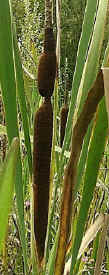Information on Selected Wetland Species
Greater Reedmace*
Typha latifolia L.

* Also incorrectly known
as Bulrush. True Bulrush is a sedge, Schoenoplectus lacustris.
In the USA, Reedmace is known as 'cattails'.
| Habitat | Greater Reedmace is generally found in very eutrophic conditions. It grows best in shallow water, usually up to 0.5m in depth, or occasionally as deep as 1m. Lesser Reedmace (Typha angustifolia) is characteristic of deeper water, up to 2m in depth. In shallower water it is outcompeted by Greater Reedmace. It is also less tolerant than Greater Reedmace of very eutrophic conditions. Greater Reedmace also occurs on exposed mud by the side of lakes, canals, ponds and ditches. It is less frequently found by streams and rivers. It may often occur in pure stands, excluding most other species. Found up to 500m in altitude. | ||
| Structure |
|
||
| Reproduction |
|
||
| Dispersal | A single inflorescence may produce
as many as 200,000 seeds! The seeds are wind dispersed. The sterile flowers in the female
heads function to keep the seeds which develop from fertile flowers as dry as possible, so
that they can be effectively dispersed. In wet weather the sterile flowers swell,
absorbing water in the inflorescence and protecting the seeds from becoming sodden and
hence too heavy for effective wind dispersal.. In dry weather, the hairs on the pedicels spread and the inflorescence 'bursts'. The fruits drift away still attached to the hairy pedicels. If they land on dry ground, the hairs remain spread so that there is the chance they may be blown away again to reach a more suitable habitat. If the fruit lands on water, the hairs remain spread for a short time, but after a few minutes, the hairs fold back. This brings the fruit into contact with the water. When wetted, the pericarp (fruit wall) springs open, releasing the seed which immediately sinks. Vegetative growth of individual plants is almost an important means of spread. Colonies may expand by growth of the rhizome at rates of 4m per year. Detached pieces of rhizome may also float away to establish new colonies. |
||
| Geographical Range |
Very widespread geographically. It occurs in temperate regions in northern latitudes, but is rare in eastern Asia. It extends south to South Africa, Central America and the West Indies and has become naturalised in Australia. In Britain, Greater Reedmace extends further north than Lesser Reedmace, reaching into Northern Scotland. |
Sources of Information
Aquatic Plants in Britain and Ireland. C.D. Preston and J.M. Croft. Harley Books, 1997.
British Water Plants. S. Haslam, C. Sinker and P. Wolseley. The Field Studies Council 1975 (1982 ed.)

